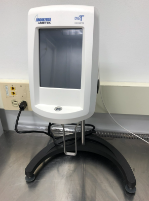Viscometry
| Brookfield DV2T Viscometer [SOP] |
|---|
| Measurement Range: 15-6,000,000 centipoise (cP) |
| Spindles: LV-1 through LV-4
Speeds: 0.1-200 rpm |
This page is currently in progress.
Theory
Viscosity is a quanity that describes the resistance to flow of a fluid. Flowing liquids have layers, and the friction between the layers contributes to the measured viscosity value. The more resistance between layers, the more force is required to move the fluid. For example, if one were to attempt to stir a spoon in a jar of honey, more force would be required to move the honey out of the way of the spoon than would be required to move the same spoon through a jar of water, as honey has a far greater viscosity than water.
Viscosity is calculated using the quantities of shear stress and shear rate. Shear stress is defined as force divided by area, and is in this case a the measured amount of force per area required to cause the fluid to move. Shear rate is the speed of the fluid caused by the force. As shown in the equation below, viscosity is the shear stress divided by the shear rate.
If a fluid is non-Newtonian, the viscosity will vary with shear rate and the spindle used. For consistent results, the same experimental conditions must be used. Most fluids are non-Newtonian. Non-Newtonian fluid types include pseudoplastics, dialtants, plastics, thixotropic fluids, and rheopexic fluid. With pseudoplastics, viscosity and shear rate have a negative relationship. Dilatants show an increase in viscosity with an increase in shear rate. Plastics may act as either Newtonian fluids, or one of the previously mentioned non-Newtonian fluid types once an initial "push" is given, such as an impact. Until disturbed by a sufficient force, plastics will act as solids and not flow. Thixotropic fluids will experience a decrease in viscosity as time passes, while rheopexic fluids will experience an increase in viscosity over time.
Fluids may experience either laminar or turbulent flow. In laminar flow, the layers of fluid move without an exchange of fluid between layers. With turbulent flow, molecules of fluid in layers will collide and move between layers. This effect is more prevalent at higher speeds, as this encourages molecules to diverge from their original layer more. When turbulent flow is present, the viscosity reading may be higher than the true viscosity. More viscous fluids are more likely to experience laminar flow. Laminar flow is the ideal condition for accurate results. If turbulence is present, lowering the speed may resolve it and make the reading more accurate.
Functionality
The viscometer rotates a spindle submerged in the fluid of interest through a spring, which measures the drag caused by the fluid. Factors determining the viscosity measurement are the spindle being used (chosen for its size), the container (this viscometer is calibrated for 600 milliliter low-form Griffin beakers), and the speed of the spindle. Prior to starting a test, the user can select a combination of spindle and rotation speed that best suits their needs and the expected viscosity of the fluid being measured. The viscometer will automatically update the maximum viscosity it can accurately measure with the selected parameters as the user changes the options (i.e. selecting a smaller spindle and/or lowering the speed will increase the range).
References
- More Solutions to Sticky Problems. https://www.brookfieldengineering.com/-/media/ametekbrookfield/tech-sheets/more-solutions-2017.pdf?la=en&revision=95201d42-069e-445d-9cd6-ddea3d9df156&hash=69A9D97710801B42C6EB8DDF014641AE[1]
- ↑ More Solutions to Sticky Problems.
